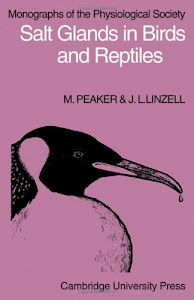
Salt Glands in Birds and Reptiles
Catégorie: Manga, Famille et bien-être
Auteur: Carole-Anne Eschenazi, Anonyme
Éditeur: Cavendish. Lucy, Insight Editions
Publié: 2017-04-09
Écrivain: Yan Schenkel
Langue: Hébreu, Sanskrit, Tchèque, Turc, Chinois
Format: eBook Kindle, epub
Auteur: Carole-Anne Eschenazi, Anonyme
Éditeur: Cavendish. Lucy, Insight Editions
Publié: 2017-04-09
Écrivain: Yan Schenkel
Langue: Hébreu, Sanskrit, Tchèque, Turc, Chinois
Format: eBook Kindle, epub
Adaptations – South Florida Aquatic Environments - Root membranes prevent salt from entering while allowing the water to pass through. This is effective at removing the majority of salt from seawater. The red mangrove is an example of a salt-excluding species. On the other hand, salt excreters remove salt through glands located on each leaf. Black and white mangroves are both salt excreters ...
Native Animals of Utah: Wildlife and Habitat - It's made up of sinks and depressions stretched between mountains. It has salt beds and lakes: The most famous, of course, is the Great Salt Lake. Its particular, very varied geography means that the Great Basin has both different deserts and forests. Mule deer The mule deer, or Odocoileus hemionus, inhabits the western side of the United States. There are different subspecies, of which the ...
Bird - Wikipedia - Like the reptiles, birds are primarily uricotelic, ... Seabirds can drink seawater and have salt glands inside the head that eliminate excess salt out of the nostrils. Most birds scoop water in their beaks and raise their head to let water run down the throat. Some species, especially of arid zones, belonging to the pigeon, finch, mousebird, button-quail and bustard families are capable of ...
Reptile - Wikipedia - Reptiles, as most commonly defined, are the animals in the class Reptilia / r ɛ p ˈ t ɪ l i ə /, a paraphyletic grouping comprising all amniotes except synapsids (mammals and their extinct relatives) and Aves (). The class comprises turtles, crocodilians, snakes, amphisbaenians, lizards, tuatara, and their extinct the traditional Linnaean classification system, birds are ...
Urinary System, Salt Glands, and Osmoregulation - Salt glands of birds likely evolved from nasal glands of reptiles, probably in the late Paleozoic. ... Thus, salt glands are not restricted to birds that live in saline or maritime habitats, but are also present in some terrestrial forms that consume little water (Sabat 2000). Salt glands have a system of countercurrent blood flow to remove and concentrate salt ions from the blood (Figures 15 ...
Gull - Wikipedia - Charadriiform birds drink salt water, ... as they possess exocrine glands located in supraorbital grooves of the skull by which salt can be excreted through the nostrils to assist the kidneys in maintaining electrolyte balance. A gull in flight. Gulls are highly adaptable feeders that opportunistically take a wide range of prey. The food taken by gulls includes fish and marine and freshwater ...
Venomous Sea Snake Facts (Hydrophiinae and Laticaudinae) - These reptiles fall into two groups: true sea snakes (subfamily Hydrophiinae) and sea kraits ... Sea snakes ingest salt with prey, so the animal has special sublingual glands under its tongue that allow it to remove excess salt from its blood and expel it with a tongue flick. Scientists don't know much about sea snake vision, but it appears to play a limited role in catching prey and selecting ...
Excretion | biology | Britannica - Excretion, the process by which animals rid themselves of waste products and of the nitrogenous by-products of metabolism. Through excretion organisms control osmotic pressure—the balance between inorganic ions and water—and maintain acid-base balance. The process thus promotes homeostasis, the
Crocodile - Wikipedia - Feeds on mammals, birds and reptiles. It is listed as Least Concern. Nile crocodile (Crocodylus niloticus) Sub-saharan Africa: A large and aggressive species with a broad snout, especially in older animals. It has a dark bronze coloration and darkens as the animal matures. Lives in a variety of freshwater habitats but is also found in brackish water. It is an apex predator that is capable of ...
Bird - Muscles and organs | Britannica - Bird - Bird - Muscles and organs: The cardiac (heart) muscles and smooth muscles of the viscera of birds resemble those of reptiles and mammals. The smooth muscles in the skin include a series of minute feather muscles, usually a pair running from a feather follicle to each of the four surrounding follicles. Some of these muscles act to raise the feathers, others to depress them.
[free], [online], [english], [epub], [audible], [kindle], [pdf], [audiobook], [read], [goodreads], [download]












0 komentar:
Posting Komentar
Catatan: Hanya anggota dari blog ini yang dapat mengirim komentar.